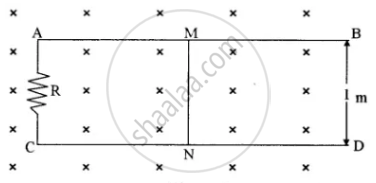Advertisements
Advertisements
प्रश्न
Two charged spherical conductors of radii R1 and R2 when connected by a conducting wire acquire charges q1 and q2 respectively. Find the ratio of their surface charge densities in terms of their radii.
उत्तर
The surface charge density for a spherical conductor is given by:
`sigma=Q/(4pir^2)`
For spherical conductor R1, the surface charge density is given by:
`sigma_1=q_1/4piR_(1^2)`
Similarly, for spherical conductor R2, the surface charge density is given by:
`sigma_2=q_2/(4piR_(2^2))`
`:.sigma_1/sigma_2=(q_1/q_2)((R_(2^2))/R_(1^2))`
Since the two conductors are connected, we have:
q1=q2
`:.sigma_1/sigma_2=R_(2^2)/R_(1^2)`
APPEARS IN
संबंधित प्रश्न
Define mobility of a charge carrier
Draw a plot of potential energy between a pair of nucleons as a function of their separation. Mark the regions where potential energy is (i) positive and (ii) negative.
Why should electrostatic field be zero inside a conductor?
Draw a plot of potential energy of a pair of nucleons as a function of their separation.
what is the significance of negative potential energy in the graph drawn?
AB and CD are two parallel conductors kept 1 m apart and connected by a resistance R of 6 Ω as shown in Figure below. They are placed in a magnetic field B = 3 × 10-2 T which is perpendicular to the plane of the conductors and directed into the paper. A Wire. MN is placed over AB and CD. and then made to slide with a velocity 2 ms-1 (Neglect the resistance of AB, CD, and MN.)

Calculate the induced c.urrent flowing through the resistor R.
A long, hollow conducting cylinder is kept coaxially inside another long, hollow conducting cylinder of larger radius. Both the cylinders are initially electrically neutral ______.
Two spherical conductors each of capacity C are charged to potential V and -V. These are then connected by means of a fine wire. The loss of energy is ______.
A 4µF condenser is charged to 400 volts and then plates are joined through a resistance of 1 kΩ The heat produced in the resistance is:
A conductor has a 14.4 × 10-19 coulomb positive charge. The conductor has ______
(Charge on electron = 1.6 × 10-19 coulomb)
